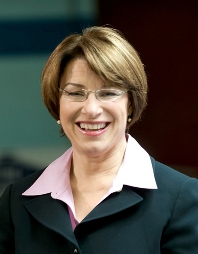Amy Klobuchar Nearly Breaks Minnesota’s US Senate Primary Record
Minnesota’s senior senator came less than a percentage point shy of the best showing in a contested Gopher State U.S. Senate primary
 Minnesota DFLer Amy Klobuchar’s U.S. Senate seat is universally considered by prognosticators to be ‘safe’ during this 2018 election cycle, and the only question heading into Tuesday’s primary against four little-known challengers was how overwhelming a victory she would record.
Minnesota DFLer Amy Klobuchar’s U.S. Senate seat is universally considered by prognosticators to be ‘safe’ during this 2018 election cycle, and the only question heading into Tuesday’s primary against four little-known challengers was how overwhelming a victory she would record.
The Gopher State’s senior senator is enormously popular and boasts one of her chamber’s highest approval ratings, which is why Klobuchar can bank on near universal support among Democrats on Election Day, as well as a clear majority of independents and a noticeable slice of Republicans – no small feat in this politically polarized country.
Senator Klobuchar’s popularity within her own party was evidenced by the 95.7 percent of the vote she won in the DFL primary – with none of her opponents reaching the two percent mark. In short, few Democratic primary voters felt the need to cast a ‘protest vote’ against her.
Smart Politics reviewed the 40 primaries for U.S. Senate held in Minnesota dating back to 1912, and Klobuchar’s 95.7 percent is the second highest support garnered by a nominee in a contested Republican, DFL, Democratic, or Farmer-Laborite primary in Gopher State history.
Klobuchar fell just short of breaking Republican Senator Rudy Boschwitz’s state record set in 1984 when he won 96.6 percent of the primary vote in a race against two other little-known candidates.
Boschwitz broke fellow delegation member Dave Durenberger’s two-year old mark when the state’s senior senator won 94.4 percent in 1982.
To date, just four major party nominees – one Democrat, one DFLer, and two Republicans – have won their party’s nomination for U.S. Senate in Minnesota without opposition.
St. Paul Democratic Mayor Daniel Lawler was unopposed in 1912 as was two-term DFL Senator Hubert Humphrey in 1960, Republican investment banker Wheelock Whitney in 1964, and Republican Lutheran minister Phil Hansen in 1972. Only Humphrey was victorious.
[Democratic U.S. Senate nominees were selected via convention rather than direct primaries for many election cycles when the party was at its low point in power from the late 1910s until the early 1940s].
Minnesota Republican and Democratic nominees have won their primaries over the decades with an average of 72.4 percent of the vote.
Incumbent senators have averaged 78.9 percent with only two failing to win their party’s nomination: Republican Moses Clapp in 1916 (placing third with 15.1 percent behind attorney Frank Kellogg and former Governor Adolph Eberhart) and Farmer-Laborite-turned-Republican Henrik Shipstead in 1946 (with 38.6 percent behind Governor Edward Thye).
The lowest support received by incumbents who prevailed in the primary were appointed (or ‘self’-appointed) to the position: DFLers Wendy Anderson (56.9 percent in 1978) and Tina Smith in 2018 (76.1 percent).
The best showing by a non-incumbent in a Minnesota U.S. Senate primary was turned in by former St. Paul Mayor Norm Coleman with the 94.4 percent support he received during the 2002 GOP primary.
Follow Smart Politics on Twitter.
